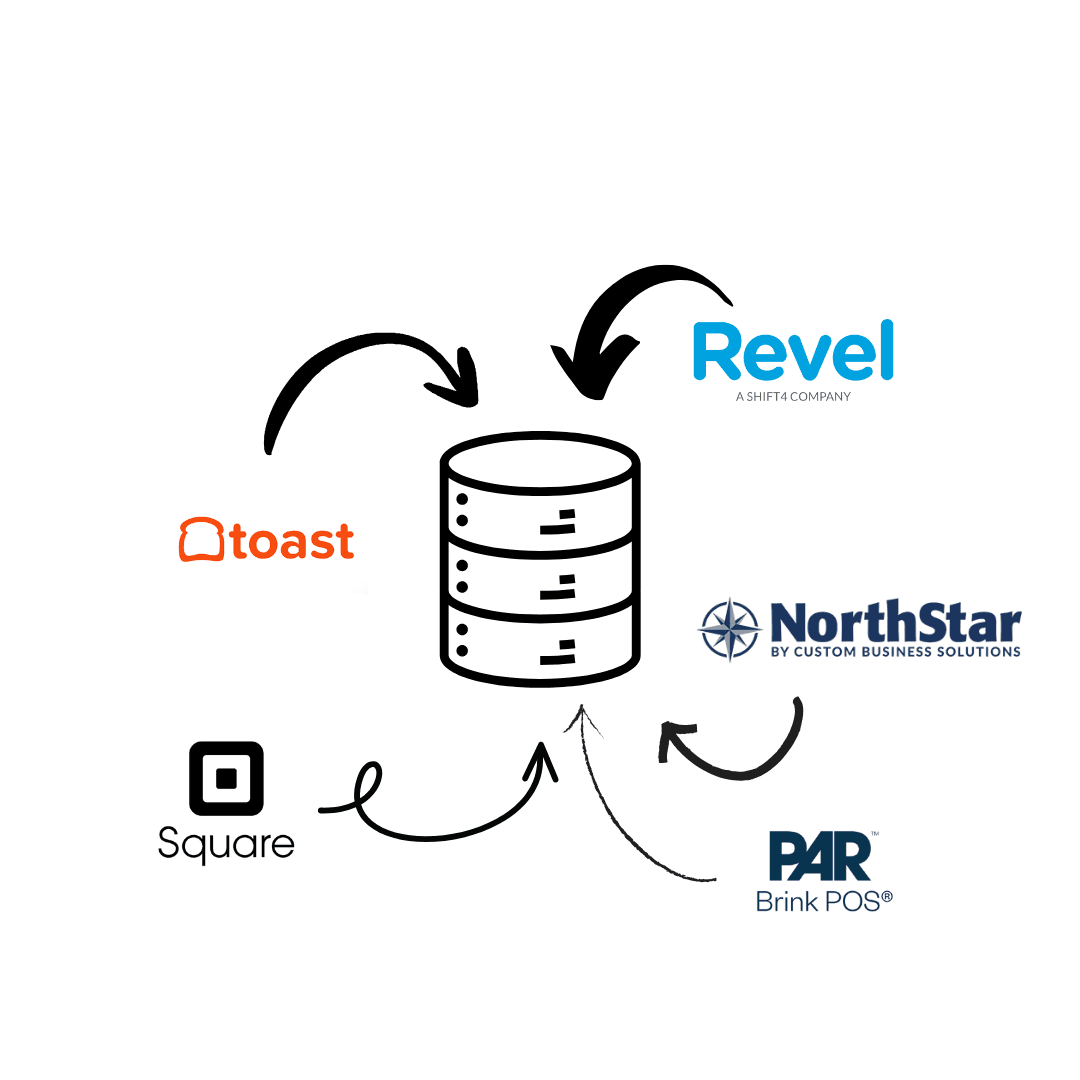Published October 9, 2025
The Understated Importance of POS-Agnostic Data Infrastructure

Why Your Restaurant Brand Needs POS-Agnostic Data Infrastructure
Here’s a fun scenario:
Your brand operates 100 locations. Corporate stores run on Toast. Your largest franchisee uses NCR Silver. Three acquired locations are on Revel. Your newest store is piloting Square because the GM insisted on it.
You need to answer a simple question: “What was our system-wide same-store sales growth last quarter?”
It takes your team three days to compile the answer. And even then, you’re not entirely confident in the number.
This isn’t a data problem. It’s an infrastructure problem.
The Multi-POS Reality
Legacy contracts allow franchisees to choose their own systems. Acquisitions bring technical debt—when you buy locations, you inherit their technology stack. New markets require specialized configurations. And that franchisee who’s been with you for 15 years? They’re not ripping out their Micros system just because corporate standardized on something else.
The result: Brands commonly operate on 2-5 different POS systems simultaneously. Each one speaks a different data language.
The Migration Problem
Your POS vendor announces a 40% price increase. Or their support deteriorates. Or a competitor releases genuinely better features. You want to switch.
But you can’t. Not easily.
Why? Because seven years of transaction data lives inside their system. Your menu performance analytics. Your customer purchase patterns. Your labor models. Everything you know about how your business operates is locked in a proprietary database.
Switching typically means:
- Lose your history – Start fresh, break year-over-year comparisons, fly blind for months
- Pay for complex migration – Six months and six figures. Hope nothing breaks.
- Maintain dual systems forever – Keep paying for the old system just to access historical data
All of these exist because of one fundamental problem: you don’t own your data.
What Data Ownership Actually Means
When your data lives exclusively inside a POS vendor’s system, you’re a tenant, not an owner.
True data ownership means:
Your data lives in your warehouse. Every transaction flows into a data warehouse you control—BigQuery, Snowflake, Databricks. The POS is just a source, not the storage.
Your POS system is swappable. Historical data exists independently of any particular POS. Switch systems tomorrow, and your seven years of transaction history stays intact and accessible.
Your analytics are vendor-independent. Dashboards, AI models, labor algorithms—they all run on your warehouse, not the vendor’s database. Change POS systems, and nothing breaks.
You negotiate from strength. When vendors know you can walk away without losing your data, renewal conversations go differently. Pricing becomes reasonable. Support improves.
What POS-Agnostic Infrastructure Means
A truly POS-agnostic platform transforms data from multiple systems into a single, unified schema that treats every transaction the same way, regardless of source.
Flexible ingestion. Connect to any POS through native APIs, SFTP feeds, or custom webhooks.
Intelligent normalization. “Caesar Salad” from Toast, “CAES SAL” from NCR, and item ID “4829” from Micros all become the same menu item in your warehouse.
Single source of truth. All data lives in one unified warehouse where your team can query across the entire enterprise without worrying about which location runs which system.
The Strategic Advantages
True enterprise analytics. Answer cross-brand questions with confidence. Same-store sales. Menu performance. Labor efficiency. All calculated consistently across every location, even if they run different POS systems.
Migrations become manageable. When a franchisee wants to switch systems, the data migration is already done—it’s been flowing into your warehouse all along.
Test systems in parallel. Pilot a new POS at three locations without committing the brand. Both systems feed the same warehouse, you compare them directly, and if the pilot fails, your data infrastructure is untouched.
Acquisition readiness. Evaluating a merger? Model the combined business before the deal closes. Integrate their data on day one, even if they run completely different systems.
Future flexibility. When a new POS vendor emerges with compelling features, add one connector and all your existing analytics work immediately.
The Implementation Reality
Building POS-agnostic infrastructure requires deep knowledge of how each POS structures data, robust ETL pipelines, intelligent mapping logic, and scalable architecture. Most brands either force expensive standardization, live with data silos, or build fragile custom integrations that break with every vendor update.
This is exactly the problem Quantiiv was built to solve. The platform automatically unifies data from any POS system—Toast, Square, NCR, Micros, Revel, or legacy systems—into a single, normalized warehouse using an enterprise data schema designed specifically for restaurant operations.
What makes Quantiiv’s approach different is that the schema is AI-ready out of the box. As brands adopt AI agents for forecasting, menu optimization, dynamic pricing, and operational recommendations, those agents need consistent, structured data to work with. Quantiiv’s schema is built to handle agentic access patterns—meaning AI systems can query, analyze, and act on your data without custom engineering for each use case. The same normalized structure that powers your dashboards today seamlessly enables your AI-driven decision-making tomorrow.
Brands get true data ownership with their complete transaction history in BigQuery or Snowflake, while Quantiiv handles the complexity of ingestion, normalization, and keeping everything in sync. Switch POS systems, acquire new locations, or pilot new technology—the data infrastructure just works, letting teams focus on insights instead of integration nightmares.
The Bottom Line
In 2025, restaurant brands compete on speed of decision-making. Winners spot trends faster, optimize pricing quicker, and respond to customer preferences before competitors do.
None of that is possible when your data lives in silos.
POS-agnostic infrastructure isn’t a “nice-to-have” feature. It’s the foundation that makes everything else possible—unified analytics, AI-powered insights, enterprise benchmarking, and strategic agility, all built on data you own.
